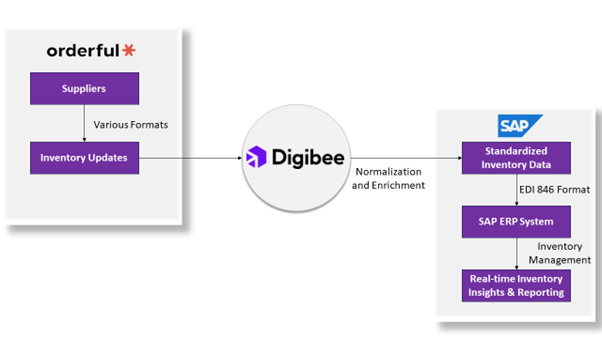
-
 Sarat Dantu
Sarat Dantu
-
 415 Views
415 Views
-
 8 Min Read
8 Min Read
-
 1 year ago
1 year ago
The retail industry is built on the foundation of accurate inventory management, yet the process of consolidating updates from numerous suppliers, each utilizing different data formats, can often spiral into a logistical nightmare. Manual merging of this diverse data into inventory management systems not only invites errors but also consumes valuable time. Enter Digibee, a seamless integration solution poised to alleviate these challenges and revolutionize inventory management processes.
According to studies conducted by the National Retail Federation, a staggering 34% of inventory discrepancies can be traced back to manual data entry errors. This alarming statistic underscores the critical need for streamlining inventory management processes through integration solutions. By doing so, the occurrence of errors can be significantly mitigated, leading to enhanced operational efficiency and increased profitability.
Digibee excels in Electronic Data Interchange (EDI) Integration by providing a seamless and efficient solution for connecting diverse systems and facilitating communication between trading partners. Leveraging advanced technologies, Digibee streamlines EDI processes, enabling swift exchange of business documents such as invoices, purchase orders, and shipping notices. Its robust integration platform ensures compatibility with various EDI standards, including ANSI X12 and EDIFACT, accommodating the specific requirements of different industries. With Digibee, organizations achieve enhanced data accuracy, reduced manual intervention, and accelerated transaction cycles, ultimately fostering smoother collaboration across supply chains and driving operational efficiency.
Digibee serves as the conduit between your chosen Enterprise Resource Planning (ERP) system, with a focus on SAP ERP—a renowned choice renowned for its robust inventory management capabilities—and your network of suppliers. Here's a closer look at how Digibee facilitates this seamless integration:

First and foremost, Digibee establishes a seamless connection with your SAP ERP system, which serves as the central repository for all inventory-related data. SAP ERP offers a suite of functionalities, including real-time inventory tracking across multiple locations, automated purchase order exchange to streamline communication with suppliers, built-in analytics for trend identification and inventory optimization, and scalability to accommodate your evolving needs and business growth.
Leveraging SAP's APIs or data export functionalities, Digibee retrieves inventory updates from your suppliers in various formats such as CSV, JSON, or XML. Subsequently, Digibee standardizes and normalizes this disparate data into a uniform format compatible with SAP ERP, thereby eliminating inconsistencies and facilitating smooth data flow.
Moreover, Digibee extends its capabilities beyond mere data transfer by enriching the inventory data with additional attributes such as SKU codes, product descriptions, and unit costs. This enrichment process draws upon reference data sources or master data management systems, thereby providing a holistic view of your inventory landscape.
In addition to seamless integration with SAP ERP, Digibee seamlessly integrates with Orderful, an Electronic Data Interchange (EDI) platform of your choice. It transforms inventory data into the appropriate EDI format, typically EDI 846 (Inventory Advice), ensuring that your trading partners receive data in a format conducive to efficient communication and collaboration.
Furthermore, Digibee incorporates robust error handling mechanisms to identify and address data transmission errors, format discrepancies, or data validation failures in real-time. With comprehensive monitoring dashboards, you gain complete visibility into the status of inventory data flow, empowering you to proactively resolve any potential issues.
By integrating SAP ERP with Digibee and Orderful, you can automate the exchange of inventory data with suppliers, thereby enhancing inventory accuracy, eliminating manual data entry errors, and gaining real-time insights into stock levels. This streamlined process fosters improved supply chain collaboration, enabling better forecasting and planning, ultimately leading to reduced carrying costs, informed decision-making, and heightened profitability.
